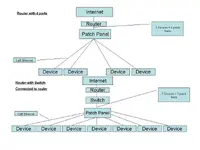B
bruiser1964
Member
Hi guys it's been a while but I'm tangled up in my new house build looking for advice from any network experts out there... Think my guy is bulls@@@ting me. 
I asked for CAT 5 network to be installed throughout and imagined this means, 1 cable per socket taken back to a central point with corresponding sockets.
What I appear to have is the sockets wired in " series" 1 cable running from socket to socket presumably ( it's not terminated yet) terminated in 1 socket.
Help! I'm calling my site manager tomorrow to sort this out and they are almost finished with sheeting out so if anyone can either confirm my suspicions that the electrician is wrong or save me an embarrassing conversation being proved an idiot
Thanks in advance
Bruce
And yes I am working on a new music room will have news on that soon and pics

I asked for CAT 5 network to be installed throughout and imagined this means, 1 cable per socket taken back to a central point with corresponding sockets.
What I appear to have is the sockets wired in " series" 1 cable running from socket to socket presumably ( it's not terminated yet) terminated in 1 socket.
Help! I'm calling my site manager tomorrow to sort this out and they are almost finished with sheeting out so if anyone can either confirm my suspicions that the electrician is wrong or save me an embarrassing conversation being proved an idiot

Thanks in advance
Bruce
And yes I am working on a new music room will have news on that soon and pics


